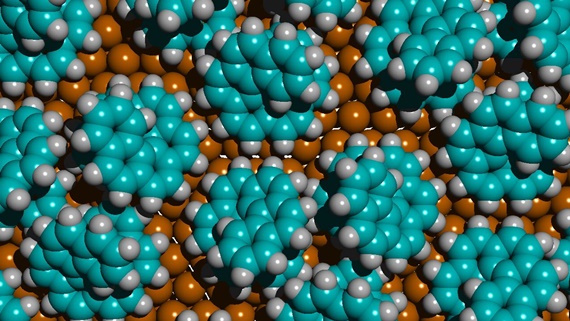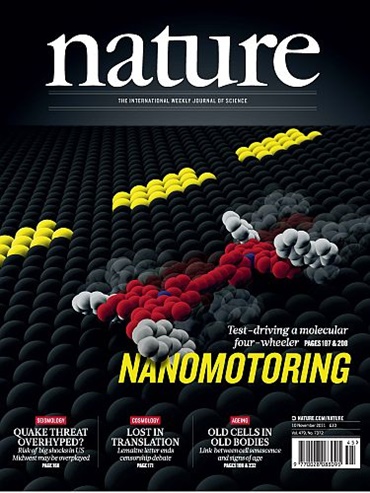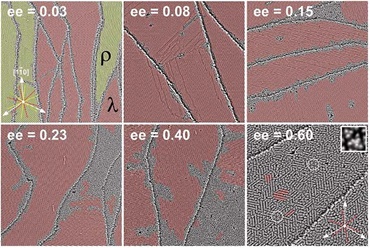Molecular Surface Science
The group Molecular Surface Science performs fundamental research on well-defined model systems in order to achieve good understanding of processes such as molecular crystallization, molecular surface dynamics and surface chemistry. In particular we focus on self-assembly of chiral molecules and non-planar aromatic systems (helicenes, buckybowls) on metallic single crystal surfaces and evaluate their potential for new molecular electronics interfaces.

Model of a monolayer of (M)-heptahelicene self-assembled on a copper surface
Single molecule surface dynamics
By excitation of molecules with inelastic tunneling electrons, we study molecular dynamics such as hopping, rotation and dissociation. Currently, we use molecular machines based on overcrowded alkenes, synthesized in the Feringa group at the University of Groningen.

Sketch of an electrically driven directional motion of a four-wheeled mole-cule on a metal surface (Cover of issue 7372, November 10th 2011)
Understanding chiral crystallization
In his famous experiment in 1848 Pasteur separated left- and right-handed ammonium sodium tartrate crystals manually and observed opposite optical activity for their aqueous solutions. His insight that the origin of chirality is based on molecular structure laid the foundation of modern structural organic chemistry. Two important details of his experiment actually allowed the manual separation: i) Handedness was transferred from the molecular structure to the macroscopic shape of the crystal (hemihedrism), and ii) the racemate precipitated into a conglomerate of enantiopure crystals. The underlying mechanisms of both processes are still poorly understood. We are neither able to predict the shape of a crystal from molecular structure nor do we know why less than ten percent of all racemates crystallize into conglomerates. One reason for the difficulty to understand and investigate these processes is their cooperative nature. Extremely small structural influences gov- ern the macroscopic result when they be- come amplified by many cooperating units. Cooperativity among different homochiral biomolecules is also of fundamental importance in life. Furthermore, the transfer of chirality into mesoscopic structures – a very important issue in liquid crystal science – is difficult to predict in three dimensions. More tractable and easier understood are two-dimensional (2D) crystals formed at surfaces, in particular because of the possibility to study these processes at the molecular level by exploitation of scanning tunneling microscopy (STM).

Sergeants-and-soldiers in 2D: STM images (200 nm x 200 nm) of chiral molecules on Cu(111) with increasing enantiomeric excess. At ee = 0.08 on-ly a single mirror domain type (λ) can exist on the surface. The enantio-meric excess at the domain boundary defines the alignment of the entire layer.

| Audio |
SRF 3 Info 5.10.2016
SRF Wissenschaftsmagazin 8.10.2016
-
Share
